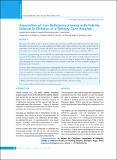Please use this identifier to cite or link to this item:
https://hdl.handle.net/20.500.14356/1047| Title: | Association of Iron Deficiency Anemia with Febrile Seizure in Children in a Tertiary Care Hospital |
| Authors: | Chaudhary, Brajesh Raj Malla, Kalpana Karmacharya Gaire, Binod |
| Citation: | Brajesh Raj Chaudhary, Karmacharya MallaK., & GaireB. (2021). Association of Iron Deficiency Anemia with Febrile Seizure in Children in a Tertiary Care Hospital. Journal of Nepal Health Research Council, 19(1), 66-70. https://doi.org/10.33314/jnhrc.v19i1.3327 |
| Issue Date: | 2021 |
| Publisher: | Nepal Health Research Council |
| Article Type: | Original Article |
| Keywords: | Children Febrile seizure Iron deficiency anemia |
| Series/Report no.: | Jan-March, 2021;3327 |
| Abstract: | Abstract Background: Febrile seizure is the most common cause of seizure in children. Iron deficiency, by lowering seizure threshold, is proposed to be one of the risk factors for febrile seizure. Many studies have been done to determine the association of iron deficiency anemia with febrile seizure but the results are controversial. Hence, the present study was conducted to evaluate the association of iron deficiency anemia with febrile seizure in Nepalese children. Methods: A prospective age and sex matched case control study was performed in 68 cases of febrile seizures and 68 controls of febrile illness without seizure after calculating the sample size. The study was conducted from October 21, 2019 to October 20, 2020 in Pediatric ward and intensive care unit of College of Medical Sciences, Bharatpur, Nepal after obtaining ethical clearance from institutional review committee. Data entry was done in statistical packages for the social science version 20. Results: Mean of haematological parameters (haemoglobin and mean corpuscular volume) as well as mean of serum iron, ferritin and transferrin saturation were significantly less and total iron binding capacity was significantly high in cases as compared to controls (P <0.05). Iron deficiency anemia was significantly associated with cases (59.7%), with odds ratio of 2.5 (95% confidence interval =1.24 – 5.01) as compared to control (40.3%) (P <0.05). Conclusions: Iron deficiency anemia may be considered one of the risk factors for febrile seizure in children. Hence, Children with febrile seizure should be investigated and treated for Iron deficiency anemia. Keywords: Children; febrile seizure; iron deficiency anemia |
| Description: | Original Article |
| URI: | http://103.69.126.140:8080/handle/20.500.14356/1047 |
| ISSN: | Print ISSN: 1727-5482; Online ISSN: 1999-6217 |
| Appears in Collections: | Vol. 19 No. 1 (2021): Vol. 19 No. 1 Issue 50 Jan-Mar 2021 |
Files in This Item:
| File | Description | Size | Format | |
|---|---|---|---|---|
| 3327-Manuscript-21551-1-10-20210425.pdf | Fulltext Article. | 243.76 kB | Adobe PDF |  View/Open |
Items in DSpace are protected by copyright, with all rights reserved, unless otherwise indicated.
